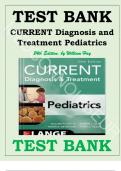TEST BANK
CURRENT Diagnosis and
M
Treatment Pediatrics
ED
24th Edition, by William Hay
C
O
N
N
O
IS
SE
U
R
TEST BANK
, Current Diagnosis and Treatment Pediatrics, 24th Edition Test Bank
Table of Contents:
Chapter 1. The Newborn Infant
Chapter 2. Child Development and Behavior
Chapter 3. Adolescence
Chapter 4. Adolescent Substance Abuse
M
Chapter 5. Eating Disorders
Chapter 6. Child and Adolescent Psychiatric Disorders
Chapter 7. Child Abuse and Neglect
ED
Chapter 8. Ambulatory / Office Pediatrics
Chapter 9. Immunization
Chapter 10. Travel Medicine
Chapter 11. Normal Childhood Nutrition and Its Disorders
Chapter 12. Emergencies and Injuries
Chapter 13. Poisoning
C
Chapter 14. Critical Care
Chapter 15. Skin
Chapter 16. Eye
O
Chapter 17. Oral Medicine and Dentistry
Chapter 18. Ear, Nose, and Throat
Chapter 19. Respiratory Tract and Mediastinum
Chapter 20. Sleep Medicine
N
Chapter 21. Cardiovascular Diseases
Chapter 22. Gastrointestinal Tract
Chapter 23. Liver and Pancreas
N
Chapter 24. Kidney and Urinary Tract
Chapter 25. Neurologic and Muscular Disorders
Chapter 26. Orthopedics
O
Chapter 27. Sports Medicine
Chapter 28. Rehabilitation Medicine
Chapter 29. Rheumatic Diseases
IS
Chapter 30. Hematologic Disorders
Chapter 31. Neoplastic Disease
Chapter 32. Pain Management and Palliative Care
Chapter 33. Immunodeficiency
SE
Chapter 34. Endocrine Disorders
Chapter 35. Diabetes Mellitus
Chapter 36. Inborn Errors of Metabolism
Chapter 37. Genetics and Dysmorphology
Chapter 38. Allergic Disorders
Chapter 39. Antimicrobial Therapy
U
Chapter 40. Infections: Viral and Rickettsial
Chapter 41. Human Immunodeficiency Virus Infection
Chapter 42. Infections: Bacterial and Spirochetal
R
Chapter 43. Infections: Parasitic and Mycotic
Chapter 44. Sexually Transmitted Infections
Chapter 45. Fluid, Electrolyte, and Acid-Base Disorders and Therapy
Chapter 46. Pediatric Laboratory Medicine and Reference Ranges
, Chapter 1: The Newborn Infant
Current Diagnosis and Treatment Pediatrics, 24th Edition Test Bank
Multiple Choice
M
1. Which milestone is developmentally appropriate for a 2-month-old infant when the nurse pulls
the infant to a sitting position?
ED
a. Head lag is present when the infants trunk is lifted.
b. The infant is able to support the head when the trunk is lifted.
c. The infant is briefly able to hold the head erect.
C
d. The infant is fully able to support and hold the head in a straight line.
O
ANS: C
A 2-month-old infant is able to hold the head erect only briefly and continues to have some head
N
lag. It is not until 4 months of age that the infant can keep his or her head in a straight line when
pulled to a sitting position.
N
2. Approximately what should a newborn weigh at 1 year of age if the newborns birth weight
O
was 7 pounds 6 ounces?
a. 14 3/4 pounds
IS
b. 22 1/8 pounds
c. 29 1/2 pounds
SE
d. Unable to estimate weight at 1 year
ANS: B
U
An infant triples the birth weight by 1 year of age. An infant doubles the birth weight by 6
months of age. An infant quadruples the birth weight by 2 years of age. Weight at 6 months, 1
year, and 2 years of age can be estimated from the birth weight.
R
, 3. Which statement made by a parent would be consistent with a developmental delay?
a. I have noticed that my 9-month-old infant responds consistently to the sound of
his name.
M
b. I have noticed that my 12-month-old child does not get herself to a sitting
position or pull to stand.
c. I am so happy when my 1 1/2-month-old infant smiles at me.
ED
d. My 5-month-old infant is not rolling over in both directions yet.
ANS: B
C
Critical developmental milestones for gross motor development in a 12 month old include
standing briefly without support, getting to a sitting position, and pulling to stand. If a 12-month-
O
old child does not perform these activities, it may be indicative of a developmental delay. An
infant who responds to his name at 9 months of age is demonstrating abilities to both hear and
N
interpret sound. A social smile is present by 2 months of age. Rolling over in both directions is
not a critical milestone for gross motor development until the child reaches 6 months of age.
N
4. At a healthy 2-month-old infants well-child clinic visit, the nurse should give which
immunizations?
O
a. DTaP, IPV, HepB, Hib, PCV, rotavirus
IS
b. MMR, DTaP, PVC, and IPV
c. Hib, DTaP, rotavirus, and OPV
d. Hib and MMR, IPV, and rotavirus
SE
ANS: A
DTaP, IPV, HepB, Hib, PCV, and rotavirus are the appropriate sequence of immunizations for a
U
healthy 2-month-old infant. MMR is given at or after 12 months of age. Oral polio vaccine
(OPV) is no longer administered in the U.S.
R
5. The nurse advises the mother of a 3-month-old infant, exclusively breast-fed, to:
a. start giving the infant a vitamin D supplement.




